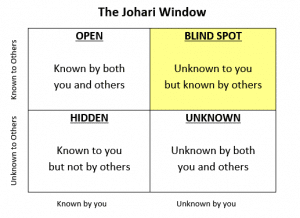If you were an executive coach who interacted with
thousands of clients over 30 years… 
… you would probably see certain characteristics emerging over and over that were “make or break” qualities in one’s success.
Dave Yarnes is just such a coach.
One of the qualities he noticed in countless individuals that seriously limited (or accelerated) their ability to succeed:
Self-Awareness – Understanding and addressing who you really are, and how you come across to others (but you can’t see)… yet everyone else can see.
In fact, this quality of “self-awareness” is so crucial that researcher Dr. Tasha Eurich called it, “The Most Important Skill of the 21st Century.”
You know people like this, right? People who are oblivious or self-deceived on how they come across.
- They think they are funny, while others cringe at their insensitive comments.
- They think they are dispensing wisdom to everyone they meet, but in reality they don’t listen well or frequently interrupt others to give their opinion.
- They think they are admired for “telling it like it is” but others avoid them because they have zero empathy or caring.
Sure, everyone knows other people who have this issue… but here’s the real problem:
Everyone (yes, that means you and me, too) are blind to certain dimensions of who we really are.
“You can fool yourself, you know. You’d think it’s impossible, but it turns out it’s the easiest thing of all.” ― Jodi Picoult
Here is what executive coach Dave Yarnes repeatedly saw: Until you address your blind spot, you will continue to limit your ability to influence others and succeed at the level you desire.
I’m going to show you an effective method to overcome this blindness… so you can become a more influential, well respected and successful person (at home, at work/school, in life).
Self-Awareness: Seeing Our Blindness
There is something about human nature that make it easy to spot a problem in others… but virtually blind to it in yourself.
“You notice the little piece of sawdust that is in another person’s eye, but you don’t notice the big piece of wood that is in your own eye.” -Jesus (Matthew 7:3)
Human observation also confirms this dynamic. Not only is it hard to see who we really are… we often prefer to believe a fantasy.
“Lying to ourselves is more deeply ingrained than lying to others.” – Fyodor Dostoyevsky
“The lies we tell other people are nothing compared to the lies we tell ourselves.” ― Derek Landy
“I suppose I have a highly developed capacity for self-delusion, so it’s no problem for me to believe that I’m somebody else!” – Daniel Day-Lewis
Person being interviewed for a job: “How are my people skills? Oh, that is one of my strengths! What kind of idiotic question is that?”
Research has identified numerous self-deceiving biases that are hard wired in us:
- Projection bias – Unconsciously assuming others share
similar thoughts, beliefs, values.
- False Consensus Effect – Overestimating the degree to which others agree with you.
Want to learn about more of the hidden influences distorting your perceptions? Get our free infographic: 50 Distorting Influences Impacting Your Perceptions of Reality
Unconsciously, we distort what we think others are perceiving about us. We assume they see us the same way we see (or want to see) ourselves.
For example, I see myself as a good listener (and believe you see this, too). But, in reality, those who know me would say, “Ummm, Pat sometimes you, umm just don’t listen. It seems like you are only waiting for your turn to talk.”
Sadly, I am blind to aspects of who I really am. We all are.
Our Blind Spot and the Johari Window
 I have found the Johari Window diagram very helpful to understand the dynamics of what is seen… and what is hidden…to you and others.
I have found the Johari Window diagram very helpful to understand the dynamics of what is seen… and what is hidden…to you and others.
We all have these 4 quadrants of understanding operating in our lives. For us to grow and become the authentic person we were created to be, we must grow in ALL the quadrants.
The Blind Spot quadrant is the hardest one (with the Hidden quadrant being a close second). Why?
Because often it is scary to face the truth. Do you really want to hear the truth that you are not as wonderful as you desperately want to believe? That there are things you do that hurt people? I can hear that song in my head…
“Tell me lies, tell me sweet little lies.” – Fleetwood Mac
Yes, it is scary. But remind yourself:
… everyone else (except you) already knows the truth… you have nothing to gain from being the only person out of step with reality.
IF you truly want to have greater positive influence and impact in the world around you, you must face reality… and work on your shortcomings.
“Self-delusion is pulling in your stomach when you step on the scales [it doesn’t change reality].” – Paul Sweeney
If you are blind to aspects of who you really are, how can you learn the truth so you can grow?
5 Effective Ways to Overcome Your Blind Spot… and Grow
1. WHERE to get the truth – Solicit feedback from others
The only way you can see what you can’t see is to enlist the help of others around you.
“The road to self-insight runs through other people.” – David Dunning, researcher (University of Michigan)
But, not just from anyone and everyone.
2. WHO to get feedback from- Select individuals
There are people in our lives who are Critical Carl or Carla. Most, if not all of their feedback is overly critical or just their opinion. They think you need to be more like them, and when you aren’t, they point it out.
Avoid these people.
Instead, identify people in your life who fit the following criteria:
- They’ve had regular interaction with you. The longer or more extensive the interaction, the better they know you.
- They are supportive and safe. People in this category don’t necessarily agree with everything you say or do, but they don’t have a consistent critical spirit (e.g. often telling you or others about the various specks in other people’s eyes).
Instead, overall they are supportive of you, believe in you, and see both the good and not so good in you. They are neither people pleasing “yes” people in your life nor constant speck identifiers.
3. HOW to get feedback from the right people
One of the biggest challenges to getting honest feedback from the right people is helping them feel safe to give their insights. Giving constructive criticism is not always easy to offer or receive.
Here are 2 ways to creating an atmosphere of safety where people feel free to say what they are thinking (and you need to hear):
- You become a welcoming vessel for honest input – People are often reluctant to offer honest feedback because they are afraid of hurting feelings, or running into a defensive buzz saw (including future repercussions).
To overcome this, YOU need to change the atmosphere around yourself. Professor Adam Grant found the best way to do this is to openly critique yourself with some regularity… and give people permission to do the same.
For example, before entering a meeting you say “I know I can speak too much in meetings—please tell me if I am.” Your colleagues will feel much safer to offer feedback, because you asked for it. And when they do, receive the feedback graciously. Even say thank you and show appreciation for their honesty.
- Allow anonymous input. Make it possible for people to provide feedback in an anonymous environment.I have found two related websites very helpful.
- This Johari Window website allows you and others to anonymously choose 5-6 words (out of 55 adjectives) that best describe you. These relate to positive attributes you exhibit.
- This Nohari Window website is similar, but allows people to select some negative traits you need to know about.
When interpreting the results, it is important to look for trends. One person’s input may be valid, but several people saying the same or similar things holds more weight.
“If one person calls you a horse, blow it off. If five do… buy a saddle.” -Henry Cloud
 I recommend that you start with the above Johari & Nohari Window suggestion, because it gives people a multiple choice format to provide feedback. But after that, you might consider trying an Open Floor feedback approach. This gives people the chance to provide feedback in any direction they think you need to know.
I recommend that you start with the above Johari & Nohari Window suggestion, because it gives people a multiple choice format to provide feedback. But after that, you might consider trying an Open Floor feedback approach. This gives people the chance to provide feedback in any direction they think you need to know.Of course, I would initially invite open floor feedback ONLY from people who I knew were supportive and not Critical Carl/Carla. Not everyone’s opinion is valid.
You can use an anonymous survey using Google Forms, or a free tool like Sayat.me. Then, people can elaborate on any topic they deem “you need to know this.”
What’s good about this approach is that sometimes helpful feedback needs some elaboration. When you hear about a specific instance where you said or did something that was hurtful, that is far clearer and more actionable than just hearing that you can be a certain way.
Also, I would prayerfully read the responses, asking God to confirm the truth (vs. someone’s critique based on their own preference for who they think you should be).
4. HOW to receive the feedback your given
There is a part in all of us that does not want or welcome honest feedback. No one really likes to be told what they are doing wrong. But, here’s the trick I have found that makes it easier: Receive the truth like you would in the 3rd person situation, distancing yourself from taking it personally.
For example, imagine you and another person are working together on a project and you present it to the boss. When the boss starts to critique areas where your colleague’s work needs to improve, do you get defensive? No. Only when the feedback is focused on you.
I am suggesting you receive feedback on yourself as though it were for someone else… an alternate version of yourself. This mental distancing helps reduce taking the feedback personally.
5. HOW to create a positive feedback (growth) loop
When you ask for feedback, and receive it, now what?
Why not enlist the help of the same safe people you just got feedback from? Leadership author Ford Taylor suggests a X step process:
- Appreciate– Approach the people who gave you feedback and express appreciation for their input. Knowing the truth is the first step in self-improvement.
- Admit– Admit to your feedback circle that you are not where you want you to be in specific areas. Then explain what those areas are. Confession can be good for the soul.
- Apologize– Apologize to your circle for the things you’ve done that have hurt them, or made them uncomfortable. No defending yourself. No blaming others. Just own it… and commit to growing in that area.
- Accountable– Invite them to tell you when they see these attitudes or actions in the future. When you do it again (and you will for a while), and they do point them out, start this process again (Appreciate, Admit, Apologize, Ask to be held accountable).
This 4 step process will help you get the upper hand on your blind spots… and really grow into a better person.
There is one additional HUGE benefit that will come your way when you use this feedback loop… your esteem in the eyes of the people around you will soar. Think about it, how do you feel about people who are honest about their faults, apologize when they step over the line, and are actively working to improve in those areas? It is hard not to admire and respect these people. You feel safe around them… and even inspired to be more like them.
Who wouldn’t want to be that kind of person?
All because you intentionally choose not to remain blind, or cling to a self-protecting fantasy. Instead, you face the truth (with a little help from your friends) and become more of the person you and others love to be around.
Your Turn!
What is the hardest part for you in growing in your self-awareness?









What a wonderful idea to help advance your efforts to succeed. I’m thinking no matter how strong your ideas may be, they’ll only take you as far as others genuinely want to help. What a great self improvement concept to embrace. Thanks Pat!
So true Kevin. You might be the sharpest knife in the drawer but if you are unknowingly putting people off, you will only go so far. Thanks for your input!
This was fantastic, and a great help! I am currently writing a paper at University on this particular topic, and this has really helped solidify some of the major concepts .
Thanks
Glad to hear it was helpful for you Briana. Good luck on your paper!
i really like your this topic. It helps 🙂
I’m glad you found it helpful John. I also applaud your courage to explore the real you… and become a better you because of it.
It’s a great source of knowledge; I think it will be helpful for lot of people who are looking for learning more about the self awareness blindness johari. Thank you very much for sharing this article.
I’m glad you found the information helpful!
Reflecting on the article’s question, the hardest part for me in growing self-awareness is likely facing the truth about my blind spots. It’s not always easy to confront aspects of ourselves that we may not want to see. However, this article reinforces the idea that embracing these truths is essential for personal development. Creating an environment where I can receive honest feedback from trusted sources and taking it in stride is a challenge, but it’s one that I’m committed to addressing.
This article is excellent. Thank you Pat!
It leads me to a question: how do we undertake improving in the quadrant that is ‘Unknown’, hidden
to both ourselves and others? I have a pattern of behaviour that not many others can see in me, my friends whom I have asked, yet my partner and some rare others see it. It is preventing me from moving forward in my self growth work.
Thank you,
Julie
The unknown quadrant (unknown to you and to others) is not something you can work on if you are unable to see issues… and receive feedback/input (either from yourself or others).
However, the situation you are referring to (“I have a pattern of behaviour that not many others can see in me, my friends whom I have asked, yet my partner and some rare others see it”) is the Blindspot quadrant, and can be worked on (and the article offers ways to do so). Even if only a few see the issue, if you have input from those who see it, you can address it.